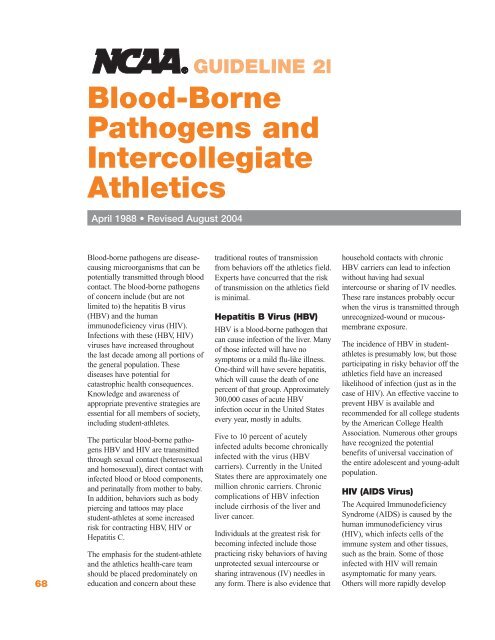Sports Medicine Handbook - NCAA
Sports Medicine Handbook - NCAA
Sports Medicine Handbook - NCAA
Create successful ePaper yourself
Turn your PDF publications into a flip-book with our unique Google optimized e-Paper software.
68<br />
Blood-Borne<br />
Pathogens and<br />
Intercollegiate<br />
Athletics<br />
April 1988 • Revised August 2004<br />
Blood-borne pathogens are diseasecausing<br />
microorganisms that can be<br />
potentially transmitted through blood<br />
contact. The blood-borne pathogens<br />
of concern in clude (but are not<br />
limited to) the hepatitis B virus<br />
(HBV) and the human<br />
immunodeficiency virus (HIV).<br />
Infections with these (HBV, HIV)<br />
viruses have increased throughout<br />
the last decade among all portions of<br />
the general population. These<br />
diseases have potential for<br />
catastrophic health con sequences.<br />
Knowledge and awareness of<br />
appropriate preventive strategies are<br />
essential for all members of society,<br />
including student-athletes.<br />
The particular blood-borne pathogens<br />
HBV and HIV are transmitted<br />
through sexual contact (heterosexual<br />
and homosexual), direct contact with<br />
infected blood or blood components,<br />
and perinatally from mother to baby.<br />
In addition, behaviors such as body<br />
piercing and tattoos may place<br />
student-athletes at some increased<br />
risk for contracting HBV, HIV or<br />
Hepatitis C.<br />
The emphasis for the student-athlete<br />
and the athletics health-care team<br />
should be placed predominately on<br />
education and concern about these<br />
GUIDELINE 2l<br />
traditional routes of transmission<br />
from behaviors off the athletics field.<br />
Experts have concurred that the risk<br />
of transmission on the athletics field<br />
is minimal.<br />
Hepatitis B Virus (HBV)<br />
HBV is a blood-borne pathogen that<br />
can cause infection of the liver. Many<br />
of those infected will have no<br />
symptoms or a mild flu-like illness.<br />
One-third will have se vere hepatitis,<br />
which will cause the death of one<br />
percent of that group. Approximately<br />
300,000 cases of acute HBV<br />
infection occur in the United States<br />
every year, mostly in adults.<br />
Five to 10 percent of acutely<br />
infected adults become chronically<br />
infected with the virus (HBV<br />
carriers). Currently in the United<br />
States there are approximately one<br />
million chronic carriers. Chronic<br />
complications of HBV infection<br />
include cirrhosis of the liver and<br />
liver cancer.<br />
Individuals at the great est risk for<br />
becoming infected include those<br />
practicing risky behaviors of having<br />
unprotected sexual intercourse or<br />
sharing intra venous (IV) needles in<br />
any form. There is also evidence that<br />
household contacts with chronic<br />
HBV carriers can lead to infection<br />
without having had sexual<br />
intercourse or sharing of IV needles.<br />
These rare instances probably occur<br />
when the virus is transmitted through<br />
unrecognized-wound or mucousmembrane<br />
exposure.<br />
The incidence of HBV in studentathletes<br />
is presumably low, but those<br />
participating in risky behavior off the<br />
athletics field have an increased<br />
likelihood of infection (just as in the<br />
case of HIV). An effective vaccine to<br />
prevent HBV is available and<br />
recommended for all college students<br />
by the American College Health<br />
Association. Numer ous other groups<br />
have recognized the potential<br />
benefits of universal vaccination of<br />
the entire adolescent and young-adult<br />
population.<br />
HIV (AIDS Virus)<br />
The Acquired Immunodeficiency<br />
Syndrome (AIDS) is caused by the<br />
human immunodeficiency virus<br />
(HIV), which infects cells of the<br />
immune system and other tissues,<br />
such as the brain. Some of those<br />
infected with HIV will remain<br />
asymptomatic for many years.<br />
Others will more rapidly develop

















